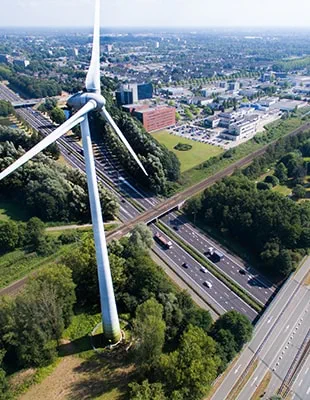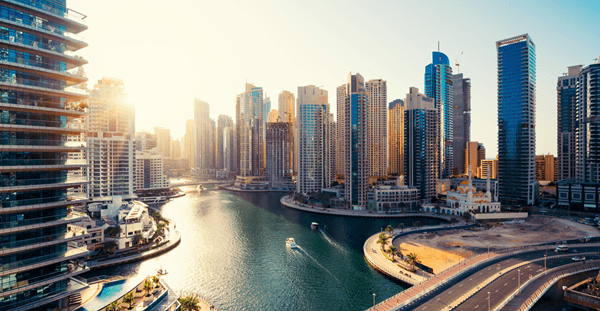Two years ago, the world established its inaugural global goals for nature at the UN Convention on Biological Diversity’s COP15 in Montreal. Now, the race is on to achieve net positive impact on nature by 2030 and its full recovery by 2050. It’s a race we can only win with significant transformation of our rapidly expanding urban systems. To add to the urgency, we can only reach our climate goals if we simultaneously reach those of biodiversity. Later this year, the world comes together in Colombia for COP16, the first biodiversity summit since the adoption of the global goals for nature at COP15. Fortunately, cities around the world are already partnering with nature, declaring nature strategies and implementing Nature-based Solutions focused on addressing urban challenges while through biodiversity.
Leveraging opportunities from grey to green
By 2020, the World Economic Forum had already identified the built environment as one of the three sectors with significant opportunity and responsibility to reverse nature loss.i It is true that cities constitute a considerable portion of this sector traditionally most damaging to nature: the urban landscape. And while they are poised to expand dramatically in size and intensity in the coming decades (with another ten megacities by 2030), it’s easy to focus on their contribution to the climate and biodiversity crises, rather than the opportunities they present.
However, cities can be leveraged for restoring environmental health.
As the global urban population reaches 7 billion in 2050, 70% of which is expected to live in urban areas, the rate of investment into and development of the built environment sector will further accelerate. Even by 2025, over 20 trillion USD of physical capital investment is needed to meet urban infrastructure demand.
What if this investment could be made with nature in mind? This is the opportunity to take a regenerative approach, in which planning of urban growth aims not just to minimize harm but rather positively impact the environment for the good of communities. Cities such as Birmingham in the UK have already acted upon this opportunity. Birmingham is aiming for 25% of green infrastructure and nature recovery to be joint funded through Green or Climate Bonds/Investment. To prioritize investments, the City Council has mapped ecosystem services against the index of multiple deprivation to create an environmental justice map.ii Next steps will see the implementation of Nature-based Solutions, defined by the International Union for the Conservation of Nature as “actions to protect, sustainably manage, and restore natural or modified ecosystems that address societal challenges effectively and adaptively, simultaneously providing human well-being and biodiversity benefits.”
Addressing societal challenges through nature
The key to this transformation is in understanding not just how we can support nature, but how in doing so we support ourselves. There are many examples of this such as greening cities to manage temperature fluctuations, address noise/air pollution and benefit human health. Or how by restoring river ecosystems, such as in our Room for the River program in the Netherlands, you can protect communities from flooding. Our Natural Capital Valuation service has also already allowed cities to make evidence-based decisions when designing and building in partnership with nature.
The transformation of built environment, specifically in the urban context, will require coordinated action between actors. For example, Prof Anusha Shah, president of the Institute for Civil Engineers, highlights the unique role of civil and infrastructure engineers in nature positive transition. “Civil and infrastructure engineers have a pivotal role to play in decarbonisation, climate adaptive infrastructure, building resilient communities and in transforming our cities to being nature and people positive. A radical shift in thinking is required both in terms of how we approach infrastructure challenges and in genuinely collaborating across sectors, geographies and generations for our shared outcomes.”
Taking a holistic approach
Sustainable project choices are central to our global strategy, ‘Accelerating a planet positive future’. In Arcadis, sustainability is defined by our five themes: Carbon, Nature, Water, Circularity and Social Impact. We strive towards taking a multifaceted approach towards achieving sustainability. For example, while it’s estimated that 60% of the world’s total greenhouse gas emissions come from our cities focusing solely on minimizing emissions is not enough. By 2050, in 136 of the world’s largest coastal cities, socio-economic change alone will lead to heightened vulnerability, even in the absence of climate change.
We have long been working on resilience, taking a holistic approach to urban concerns. Our work encompasses all its aspects, future-proofing cities and infrastructure against our ever-heating climate and all the challenges it presents. The Lower Manhattan resilience project is an example of this, protecting 62,000 residents from flooding.
Looking towards the next biodiversity COP
Later this year, Colombia will host COP16 and has recently branded it the ‘People’s COP’. Several cities were represented at the previous COP and we expect similar, if not more engagement from them this year. “There is a rising appreciation and expectation for cities to address societal challenges in a nature positive manner as well as contribute significantly to our global goals for nature.” Jacqui Banks, Melbourne City Executive, is encouraged by the opportunities for cities and urban actors to engage in global processes. “In Australia, hosting the program of global events such as the Nature Positive Cities Symposium and the UN Nature Positive Summit, mean our cities are well placed to set the pace at COP16.”
It is now more important than ever to recognize what nature provides for people and its interconnectedness with social value alongside other sustainability themes. And it is equally crucial for us to fast-track our initiatives on conserving, managing and restoring the environment alongside urban expansion, if we are to meet our goals by 2050.
Follow our Road to Biodiversity COP16 blogs to stay updated on the state of nature on the global stage this year, and what that means for the built environment.









